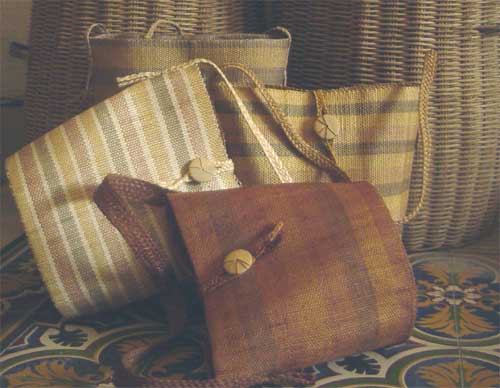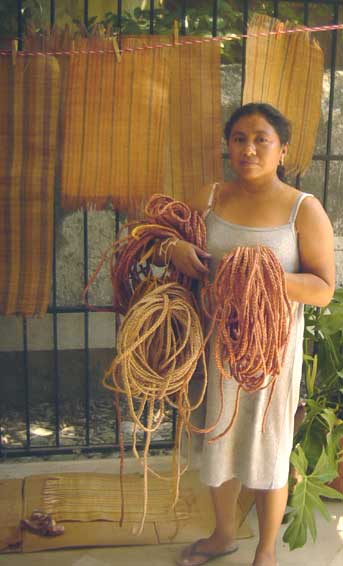


Clementina Iuit, shown above, and I make purses, handbags and backpacks using cloth and braid made to our specifications by village artisans who have been working with henequen for generations. We sell our products in Merida's Sunday craft market, "Merida en Domingo". If someone misses us in the market, we can always make time to receive people in our workshop.
Besides the products we make we also design and sell coiled henequen containers made for us by Marina Chuc who has been working directly with us since the "Traditional Henequen Craft Project" of 1998. We also handle rustic basketry made by our friend Paulino. He started creating his own baskets a few years ago after I noticed that he delivered rolls of vine materials to one of his neighbors. We find it satisfying to discover, encourage and challenge artisans to keep their traditional crafts alive. Over the years we have been learning, experimenting, linking woven cloth with other techniques, refining and slowly evolving to make more marketable products. Why do we continually ask questions? We are interested in what can happen. We do not need to make the exact same thing over and over. We are making craft.
WHAT'S IN A NAME?
Henequen [ pronounced: HEN ah kin] is the Spanish name for the plant: Agave fourcroydes. The Maya word for the plant is variously written Kij, Kih, or Kiiw.
The Maya word for the fiber is Sook', So'ok', or Sod skil.
Sisal [pronounced: SIGH saul] is often used to mean Henequen fiber. However, it is not uncommon that the name is used for any rough, coarse twine and fabric. The Sisal fiber of Africa and Brazil are selected varieties of the original Agave, smuggled out of the Yucatan early on. The variations in characteristics are due to the selection of clones and to different growing conditions.
Burlap bags can be made of Sisal -- meaning henequen -- or jute or other fibers. Henequen/sisal twine is the baling twine used for putting up hay.
Sisal [pronounced: see SAL[as in sally]] is the name of the port through which the bales and crates of the henequen fiber, rope, and binder twine were shipped to the rest of the world. The crates, bundles and bags were stamped in large letters with the name of the port of origin, Sisal, and this became the commonly used name for the fiber. Sisal was an ancient Maya port. However, as railroads and factories sprung up in and around Merida, the new port of Progreso was developed directly north of the city.
Sakal [pronounced sah Kal] is the Maya name for the panels of henequen cloth woven of fibers, not thread or twine on the back-strap loom. The size of the panel is limited to the length of the fiber strands, by the width that the weaver can reach, and by the weight that her back can support. Paños is the Spanish word.
When we began looking for craft, I was surprised to find no visible sign of weaving, even though we were traveling in the towns pinpointed as centers for crafting henequen. One day we located a Maya woman who represented a craft cooperative that finally led us to weavers. Although weavers were busy doing things in their homes, there were no looms in sight until Doña Juana Francisca invited us into the rear of her cement block, one-room house. She did her weaving on the dirt floor of a lean-to structure where she cooked over an open fire. On the ground were what appeared to be a few well-worn sticks in a pile of henequen fiber. That was the loom she was using. I was amazed to see that the henequen cloth panels she showed us were woven on a back-strap loom. More amazing was the realization that the warp was made of single strands of fiber rather than thread; I never heard this mentioned when I spoke with craft experts. This was a revelation, and I was definitely hooked! There are subtle differences between the back-strap looms used with sisal and those used with cotton or other soft fibers. These subtleties make hard fiber cloth something more than just another woven product. The biggest difference is that the sakal (henequen cloth) is woven from strands of fiber.
And so, our education into the ways of hard fiber weaving started there. I had no knowledge of the Yucatec Maya language, and Clementina had no experience with the Maya vocabulary related to sisal craft. We began to visit villages, observing, sometimes participating in the hand rasping, the washing and drying, and setting up warps and looms.
Interestingly, like most Maya activities, producing craft in a village is a communal activity. The chores of washing, combing, carding, selecting fibers of the same length, setting up the warps, and other chores are done by different people, usually the people all coming from the same family compound.
After about 6 months, a state-run craft competition was announced and we decided to form a team to design and create handbags to submit for the competition. We made 3 samples dividing the work according to the specialty of each artisan...one prepared and dyed the fiber, another produced the cloth and the third made the handbag. Because we had submitted a team project we did not receive the top award but our designs were included among the most outstanding designs exhibited. We received honorable mention in the competition and pictures of the bags appeared in the local newspapers. This recognition gave our project validity among the henequen artisans.